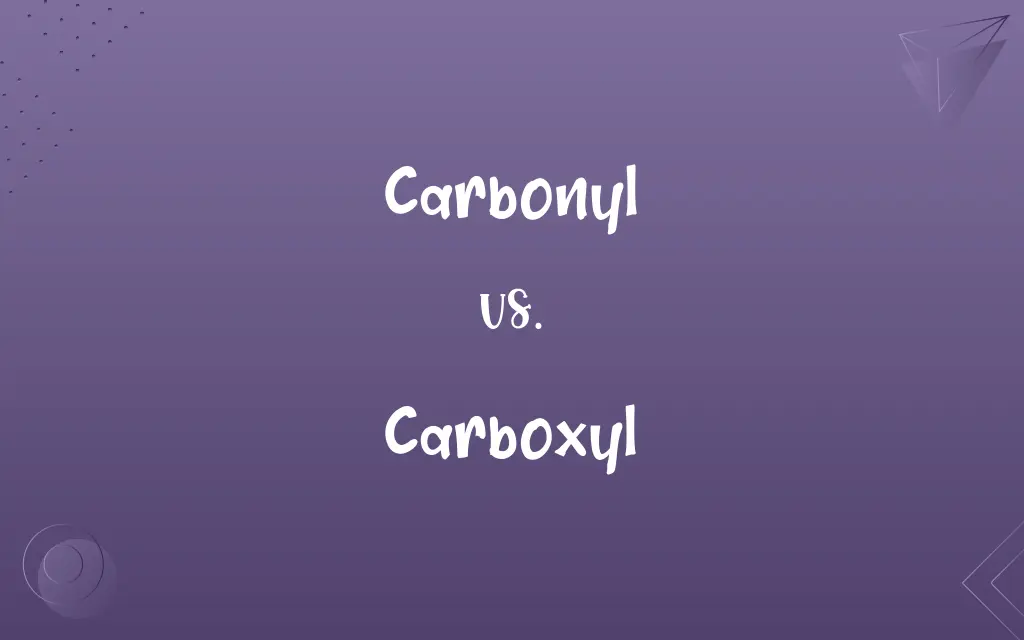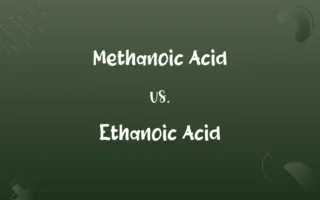Carbonyl vs. Carboxyl: Know the Difference

By Shumaila Saeed || Published on January 7, 2024
Carbonyl is a functional group with a carbon atom double-bonded to an oxygen (C=O), whereas Carboxyl contains a carbonyl and a hydroxyl group (COOH).

Key Differences
Carbonyl groups are characterized by a carbon atom double-bonded to an oxygen atom. They are a key feature in various organic compounds, including aldehydes and ketones. In contrast, a carboxyl group combines a carbonyl group with a hydroxyl group (OH), making it a defining feature of carboxylic acids. This structural difference leads to distinct chemical properties and reactivities.
Shumaila Saeed
Jan 07, 2024
In the context of molecular structure, carbonyl groups contribute to the polarity of molecules due to the electronegativity of oxygen, affecting solubility and boiling points. Carboxyl groups, on the other hand, are more polar due to the additional OH group, impacting solubility and acidity of compounds like amino acids and fatty acids.
Shumaila Saeed
Jan 07, 2024
The reactivity of carbonyl groups in organic synthesis is significant, with reactions often occurring at the carbon of the C=O bond. In contrast, carboxyl groups are known for their acidic properties, as they can donate a hydrogen ion (H+) from the hydroxyl part, leading to the formation of carboxylate ions in solution.
Shumaila Saeed
Jan 07, 2024
In biological systems, carbonyl groups are integral to the structure and function of sugars and proteins. Carboxyl groups, however, play a crucial role in energy metabolism and protein synthesis due to their presence in amino acids and fatty acids.
Shumaila Saeed
Jan 07, 2024
The physical properties of compounds containing carbonyl groups, such as aldehydes and ketones, differ markedly from those with carboxyl groups, like carboxylic acids and esters. This is due to the differences in bonding and the presence of the hydroxyl group in carboxyl groups.
Shumaila Saeed
Jan 07, 2024
ADVERTISEMENT
Comparison Chart
Chemical Reactivity
Reactivity at C=O carbon
Acidic properties, forms carboxylate ions
Shumaila Saeed
Jan 07, 2024
Physical Properties
Varies with compound type
Generally more polar, affects solubility
Shumaila Saeed
Jan 07, 2024
ADVERTISEMENT
Carbonyl and Carboxyl Definitions
Carbonyl
In carbonyl compounds, the carbon-oxygen double bond is a site of chemical reactivity.
In benzaldehyde, the carbonyl group is reactive and forms various derivatives.
Shumaila Saeed
Dec 17, 2023
Carboxyl
Carboxyl groups can ionize in solution, releasing a hydrogen ion and forming a carboxylate ion.
In vinegar, the acetic acid partially ionizes, releasing hydrogen ions from its carboxyl group.
Shumaila Saeed
Dec 17, 2023
Carbonyl
Carbonyl groups characterize aldehydes and ketones, essential in organic chemistry.
Acetone, a common solvent, is a ketone with a central carbonyl group.
Shumaila Saeed
Dec 17, 2023
Carboxyl
A carboxyl group is a functional group consisting of a carbonyl and a hydroxyl group (COOH).
Acetic acid contains a carboxyl group, giving it acidic properties.
Shumaila Saeed
Dec 17, 2023
Carbonyl
A carbonyl is a functional group consisting of a carbon atom double-bonded to an oxygen atom.
Formaldehyde, a simple aldehyde, contains a carbonyl group.
Shumaila Saeed
Dec 17, 2023
ADVERTISEMENT
Carboxyl
The presence of a carboxyl group significantly affects the solubility and reactivity of organic compounds.
Benzoic acid, used as a food preservative, is more soluble in hot water due to its carboxyl group.
Shumaila Saeed
Dec 17, 2023
Carbonyl
Carbonyl groups influence the physical properties like boiling point and solubility of organic molecules.
Acetaldehyde has a higher boiling point due to its carbonyl group.
Shumaila Saeed
Dec 17, 2023
Carboxyl
In biological molecules, carboxyl groups are essential in amino acids and fatty acids.
Glycine, an amino acid, contains a carboxyl group critical for protein structure.
Shumaila Saeed
Dec 17, 2023
Carbonyl
In biochemistry, carbonyl groups are present in sugars and contribute to their structure.
Glucose, a simple sugar, contains a carbonyl group that defines its aldose structure.
Shumaila Saeed
Dec 17, 2023
Carboxyl
Carboxyl groups are the defining feature of carboxylic acids and are acidic in nature.
Citric acid, found in citrus fruits, contains three carboxyl groups.
Shumaila Saeed
Dec 17, 2023
Carboxyl
The univalent group, -COOH, the functional group characteristic of all organic acids.
Shumaila Saeed
Dec 13, 2023
Carboxyl
(organic chemistry) A univalent functional group consisting of a carbonyl and a hydroxyl functional group (-CO.OH); characteristic of carboxylic acids.
Shumaila Saeed
Dec 13, 2023
Carbonyl
(organic chemistry) In organic chemistry, a divalent functional group, (-CO-), characteristic of aldehydes, ketones, carboxylic acids, amides, carboxylic acid anhydrides, carbonyl halides, esters and others.
Shumaila Saeed
Dec 13, 2023
Carboxyl
The complex radical, CO.OH, regarded as the essential and characteristic constituent which all oxygen acids of carbon (as formic, acetic, benzoic acids, etc.) have in common; - called also oxatyl.
Shumaila Saeed
Dec 13, 2023
Carbonyl
(inorganic chemistry) Any compound of a metal with carbon monoxide, such as nickel carbonyl, Ni(CO)4.
Shumaila Saeed
Dec 13, 2023
Carboxyl
The univalent radical -COOH; present in and characteristic of organic acids
Shumaila Saeed
Dec 13, 2023
Carbonyl
The radical (CO)´´, occuring, always combined, in many compounds, as the aldehydes, the ketones, urea, carbonyl chloride, etc.
Shumaila Saeed
Dec 13, 2023
Repeatedly Asked Queries
Are carbonyl groups present in biological molecules?
Yes, especially in sugars and certain proteins.
Shumaila Saeed
Jan 07, 2024
How does a carbonyl group affect a molecule's properties?
It affects the molecule's polarity, solubility, and reactivity.
Shumaila Saeed
Jan 07, 2024
What is a carboxyl group?
A functional group consisting of a carbonyl and a hydroxyl group (COOH).
Shumaila Saeed
Jan 07, 2024
Can carbonyl groups participate in chemical reactions?
Yes, they are reactive sites in many organic reactions.
Shumaila Saeed
Jan 07, 2024
Where are carbonyl groups commonly found?
In aldehydes and ketones, as part of their molecular structure.
Shumaila Saeed
Jan 07, 2024
What role do carboxyl groups play in amino acids?
They contribute to the acid-base properties and protein structure.
Shumaila Saeed
Jan 07, 2024
What is a carbonyl group?
A functional group in organic chemistry with a carbon atom double-bonded to an oxygen atom.
Shumaila Saeed
Jan 07, 2024
What types of compounds contain carboxyl groups?
Mainly carboxylic acids, but also in amino acids and fatty acids.
Shumaila Saeed
Jan 07, 2024
How do carboxyl groups behave in water?
They can ionize, releasing hydrogen ions and forming carboxylate ions.
Shumaila Saeed
Jan 07, 2024
Are carbonyl groups found in fatty acids?
No, fatty acids typically contain carboxyl groups.
Shumaila Saeed
Jan 07, 2024
How does the presence of a carboxyl group affect solubility?
It generally increases solubility in water due to polarity.
Shumaila Saeed
Jan 07, 2024
Are carboxyl groups important in biochemistry?
Yes, particularly in the structure and function of proteins and fatty acids.
Shumaila Saeed
Jan 07, 2024
How do carbonyl groups influence boiling points?
They increase boiling points due to increased polarity.
Shumaila Saeed
Jan 07, 2024
What is the significance of carboxyl groups in metabolism?
They are crucial in energy production and biosynthesis pathways.
Shumaila Saeed
Jan 07, 2024
What is the difference between carbonyl and carboxyl groups?
A carbonyl is C=O; a carboxyl includes this plus an OH group (COOH).
Shumaila Saeed
Jan 07, 2024
Do carbonyl groups make a compound acidic?
No, that property is specific to carboxyl groups.
Shumaila Saeed
Jan 07, 2024
Can carboxyl groups form salts?
Yes, when they lose an H+ ion and react with bases.
Shumaila Saeed
Jan 07, 2024
Do carbonyl groups participate in hydrogen bonding?
Yes, they can engage in hydrogen bonding due to the oxygen atom.
Shumaila Saeed
Jan 07, 2024
Can carbonyl and carboxyl groups be modified chemically?
Yes, both can undergo various chemical reactions.
Shumaila Saeed
Jan 07, 2024
Can carbonyl and carboxyl groups be identified spectroscopically?
Yes, using techniques like infrared spectroscopy.
Shumaila Saeed
Jan 07, 2024
Share this page
Link for your blog / website
HTML
Link to share via messenger
About Author
Written by
Shumaila SaeedShumaila Saeed, an expert content creator with 6 years of experience, specializes in distilling complex topics into easily digestible comparisons, shining a light on the nuances that both inform and educate readers with clarity and accuracy.









































































